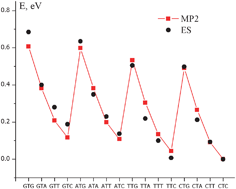Stabilization of radical anion states of nucleobases in DNA
Abstract
Trapping of an electron by DNA leads to the formation of

- This article is part of the themed collection: Nucleic acid simulations
a Institució Catalana de Recerca i Estudis Avançats, Barcelona 08010, Spain
b
Institut de Química Computational, Departament de Química, Universitat de Girona, 17071 Girona, Spain
E-mail:
alexander.voityuk@icrea.es
Trapping of an electron by DNA leads to the formation of

 Please wait while we load your content...
Something went wrong. Try again?
Please wait while we load your content...
Something went wrong. Try again?
A. A. Voityuk, Phys. Chem. Chem. Phys., 2009, 11, 10608 DOI: 10.1039/B910690A
To request permission to reproduce material from this article, please go to the Copyright Clearance Center request page.
If you are an author contributing to an RSC publication, you do not need to request permission provided correct acknowledgement is given.
If you are the author of this article, you do not need to request permission to reproduce figures and diagrams provided correct acknowledgement is given. If you want to reproduce the whole article in a third-party publication (excluding your thesis/dissertation for which permission is not required) please go to the Copyright Clearance Center request page.
Read more about how to correctly acknowledge RSC content.
 Fetching data from CrossRef.
Fetching data from CrossRef.
This may take some time to load.
Loading related content
